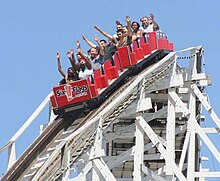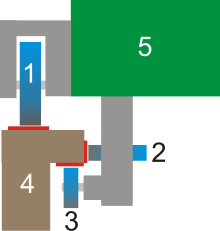John A. Miller

John A. Miller (* 1872 in Homewood , Illinois ; † June 24, 1941 Houston , Texas , born August John Mueller) was an American inventor , roller coaster designer and constructor. He became known through many inventions that still play an important role in roller coaster construction today; like the roll-back protection or the underfriction wheels - wheels that hold the wagons on the rails from below. He was able to secure more than 100 patents in the field of roller coaster technology and safety and was involved in the construction of more than 130 roller coasters. Often he is called "Thomas Edison the roller coaster ”.
biography
At the age of 19, Miller began working for the company of roller coaster pioneer LaMarcus Adna Thompson , where he soon became the chief technician. Together, Thomson and Miller developed the roller coaster further and registered a number of patents. Starting in 1911, Miller designed around 15 roller coasters as a consultant for the Philadelphia Toboggan Company .
In 1920 Miller founded Miller and Baker, Inc. with Harry C. Baker , a successful contractor specializing in the construction of roller coasters. During that time, the company built more than 40 roller coasters. Including new developments like the Dip-Lo-Docus roller coasters with rotating carriages . The two separated again in 1923 and continued to work with their own companies. Harry Baker's company built the famous Cyclone in Coney Island in 1927 . Miller founded the John A. Miller Company, Inc.
In the late 1920s, Miller partnered again. The Flying Turns were developed together with Norman Bartlett , a type of roller coaster similar to a bobsleigh run , whose vehicles do not run on rails, but with rubber wheels in a channel made of wood. The first track of its kind opened in Lakeside Park in Dayton in 1929 . Due to the global economic crisis , the joint company went bankrupt in 1932. Bartlett was then able to build a few more flying turns .
Little is known of Miller's later years. In 1936 he built two triple racers , racing coasters with three tracks, in Dallas and Louisville . He spent a lot of time in Mexico in the late 1930s . He died while planning a roller coaster for Houston, Texas on June 24, 1941.
Inventions
The underfriction wheels patented in 1919 are considered Miller's most important invention . The roller coaster cars are held firmly on the route by these wheels reaching under the rails. This made it possible to construct steeper descents, hills with more airtime and more inclined curves than with only side friction roller coasters and enabled the development of modern roller coasters. To this day, most roller coasters use trolleys based on this invention, but the frame and rail construction of wooden roller coasters has hardly changed since then.

In 1910, Miller patented the safety chain dog , a simple metal bar which at rupture of the drive chain of the elevator Hills prevents the rolling back of the car, as he engages in locking on the inclined plane. This safety device triggers the typical "clacking" when pulling up the carts of many roller coasters.
Miller also patented various types of roller coaster cars and trains, braking devices, safety bars and types of roller coasters. He also held a patent for a type of giant wheel with gondolas rolling on rails, which was never realized.
roller coaster
Today only nine of the more than 130 railways built with Miller involvement are still in operation:
| Surname | park | Opened |
|---|---|---|
| Big Dipper | Pleasure Beach Blackpool | 1923 |
| Classic Coaster | Washington State Fair | 1935 |
| Jack Rabbit | Kennywood | 1920 |
| Jack Rabbit | Seabreeze Amusement Park | 1920 |
| Legend | Arnold's Park | 1930 |
| Racer | Kennywood | 1927 |
| Roller coaster | Lagoon | 1921 |
| The Wild One (Giant Coaster) | Six Flags America | 1917 |
| Zippin Pippin | Bay Beach Amusement Park | 1912 |
literature
- Robert Cartmell: The Incredible Scream Machine: A History of the Roller Coaster Bowling Green State University Popular Press, 1987, ISBN 0-87972-341-6
Web links
- MIT Inventor of the Week Archive: John Miller - Roller Coaster Innovations. Retrieved April 13, 2013 .
Individual evidence
- ^ Roller coasters with the participation of John A. Miller in the Roller coaster database. Retrieved April 13, 2013 .
- ↑ US Patent 1319888, Pleasure railways structure. Retrieved April 14, 2013 .
- ↑ US Patent 979984, Safety device for pleasure railways. Retrieved April 14, 2013 .
- ↑ U.S. Patent 1539094, Amusement structure. Retrieved April 14, 2013 .
| personal data | |
|---|---|
| SURNAME | Miller, John A. |
| ALTERNATIVE NAMES | Mueller, August John; Thomas Edison of the roller coaster |
| BRIEF DESCRIPTION | American inventor, engineer, roller coaster designer and constructor |
| DATE OF BIRTH | 1872 |
| PLACE OF BIRTH | Homewood (Illinois) , Illinois |
| DATE OF DEATH | June 24, 1941 |
| Place of death | Houston , Texas |
